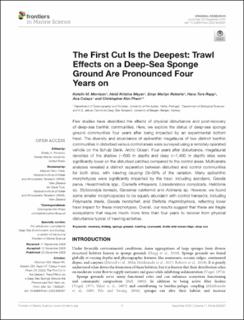The First Cut Is the Deepest: Trawl Effects on a Deep-Sea Sponge Ground Are Pronounced Four Years on
Morrison, Katelin M.; Meyer, Heidi Kristina; Roberts, Emyr Martyn; Rapp, Hans Tore; Colaço, Ana; Pham, Christopher K.
Journal article, Peer reviewed
Published version

Åpne
Permanent lenke
https://hdl.handle.net/11250/2766490Utgivelsesdato
2020Metadata
Vis full innførselSamlinger
- Department of Biological Sciences [2232]
- Registrations from Cristin [9766]
Sammendrag
Few studies have described the effects of physical disturbance and post-recovery of deep-sea benthic communities. Here, we explore the status of deep-sea sponge ground communities four years after being impacted by an experimental bottom trawl. The diversity and abundance of epibenthic megafauna of two distinct benthic communities in disturbed versus control areas were surveyed using a remotely operated vehicle on the Schulz Bank, Arctic Ocean. Four years after disturbance, megafaunal densities of the shallow (∼600 m depth) and deep (∼1,400 m depth) sites were significantly lower on the disturbed patches compared to the control areas. Multivariate analyses revealed a distinct separation between disturbed and control communities for both sites, with trawling causing 29–58% of the variation. Many epibenthic morphotypes were significantly impacted by the trawl, including ascidians, Geodia parva, Hexactinellida spp., Craniella infrequens, Lissodendoryx complicata, Haliclonia sp. Stylocordyla borealis, Gersemia rubiformis and Actiniaria sp. However, we found some smaller morphospecies to be equally abundant with control transects, including Polymastia thielei, Geodia hentscheli, and Stelletta rhaphidiophora, reflecting lower trawl impact for these morphotypes. Overall, our results suggest that these are fragile ecosystems that require much more time than four years to recover from physical disturbance typical of trawling activities.
